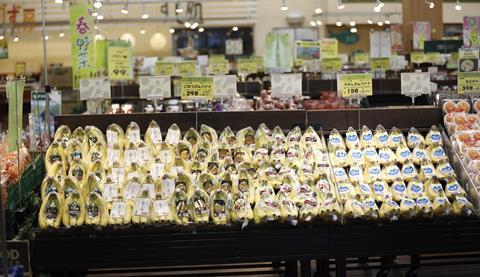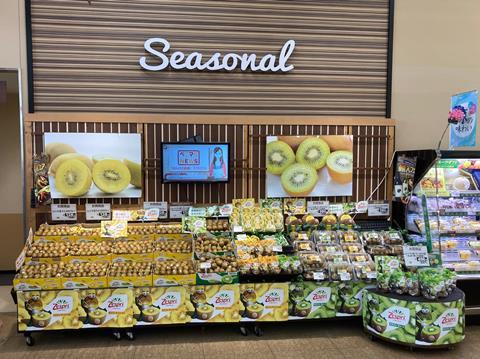Total fruit imports stay below ten-year average in 2024, but reach record value due to weak yen
Japan imported 1.599mn tonnes of fresh fruit in the 2024 calendar year, almost the same level as the 1.593mn tonnes imported in 2023, according to the latest data from the Ministry of Finance.

Total import volumes remained below the ten-year average of 1.649mn tonnes, but the overall value of imports reached a record ¥334bn (US$2.157bn), reflecting the weakness of the Japanese yen.
As in previous years, imports were dominated by five products. Bananas remained by far the largest category, representing 65.1 per cent of total fresh fruit imports. Rounding out the top five were pineapples with a 9.8 per cent share, kiwifruit (7.2 per cent), oranges (4.7 per cent) and avocados (3 per cent).
Together, these top five items represented 89.9 per cent of total fresh fruit imports. This marks an increase on previous years and indicates they will dominate imports in the future.
Over the past ten years, banana and pineapple import volumes have remained stable while kiwifruit has shown an upward trend. Other fruits such as oranges, lemons, grapefruit, grapes and lemons have drifted downwards.
The weakness of the yen has pushed up purchasing costs for Japanese importers and it continued to impact their profitability in 2024.
Bananas: new suppliers gain foothold
Japan imported a total of 1.041mn tonnes of bananas in 2024, marking the seventh consecutive year that banana imports have topped a million tonnes. While the Philippines is still by far the dominant supplier with more than 75 per cent market share, it lost ground to newer supply origins such as Vietnam (3.2 per cent), Laos (1 per cent) and Cambodia. Previously, these supplying countries have focused on exporting to China, and it remains to be seen whether they can ship more volume to Japan.
Pineapples: Taiwan takes share
Pineapple imports were down 4 per cent on 2024 volumes, at 157,000 tonnes, but they have remained relatively stable over the past ten years. The main question now is how Taiwanese pineapples, which lost access to the China market in 2020, will perform in Japan. While the Philippines continues to dominate the pineapple market, accounting for more than 87 per cent of import volumes in 2024, Taiwan’s share grew to 12.2 per cent.
Kiwifruit remains only growth category
Kiwifruit was the third-largest fruit import category by volume after bananas and pineapples. Imports reached almost 116,000 tonnes, which represented the second-largest volume ever imported after the record 118,000 tonnes shipped in 2021. New Zealand accounted for some 97.6 per cent of the total import volume.
Kiwifruit continues to buck the trend in the Japanese market as the only fruit import item to show growth in sales. It is also performing well in value terms. Kiwifruit was the second largest category after bananas in 2024, with total imports worth ¥59bn (US$384mn). Banana imports were worth ¥147.205bn (US$950mn).

Oranges: two key suppliers dominate
Orange imports registered a 9 per cent increase year-on-year in 2024, reaching 75,397 tonnes, but they remained below the ten-year average.
Australia has steadily grown its share to account for over half of imports in 2024 (55.9 per cent). The US remained the other key supplier, supplying 39.6 per cent of imports. Turkey has also gained a foothold in the market over the past three years, and supplied 3 per cent of total orange imports in 2024.
Avocado imports drop
Avocado imports fell 22 per cent year-on-year in 2024 to 48,870 tonnes. Since peaking at 80,000 tonnes in 2020, Japan’s avocado imports have declined significantly, largely reflecting the nation’s weaker buying power versus competing markets.
If the US goes ahead with imposing an additional 25 per cent tariff on Mexican avocado imports, Mexican growers may look to move more fruit into the Japanese market. Mexico still accounted for around three-quarters of total import volumes (74.3 per cent) in 2024, followed by Peru (22.7 per cent).
Limited potential for lemons
Lemon import volumes remained virtually unchanged at 43,169 tonnes. Japan’s lemon imports have declined over the past ten years as market demand has contracted. Chile dominates Southern Hemisphere supply (48.6 per cent of total import volumes) and the US leads Northern Hemisphere supply (33.2 per cent). Australia has grown its share from a low base and accounted for 8.8 per cent of lemon imports in 2024.
Grape competition heats up
Grape imports totalled 26,643 tonnes, marking an 8 per cent decline on 2023. Chile continued to dominate the market with a 45.6 per cent market share. However, Peru has increased its market share to 11.8 per cent since securing market access in 2023. Australia’s share contracted to 14.3 per cent in 2024 after controllling a quarter of the market in the early 2020s. But Australian grapes could gain market share in 2025 after the industry recently secured full varietal access to Japan.





